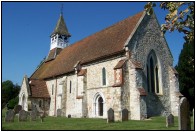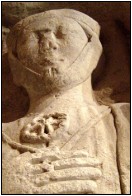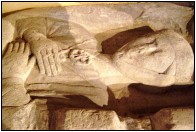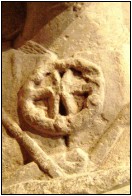| |
 
MYSTERY
TOMB AT EAST WORLDHAM
 |
|
On a hill above
Alton, and possibly on the old
Pilgrim’s way from Winchester to
Canterbury, stands the little 13th
century church of St Mary at East
Worldham. It
was thoroughly Victorianised in the
middle of the 19th century, and during
the inevitable excavations, the builders
made a remarkable find, which has
intrigued and divided scholars ever
since.
|
It was the effigy of a
lady, dressed in costume of the 14th century,
wearing a brooch in the shape of a wheel. The
wheel was the badge of the Roet family, one of
whom married the poet, Geoffrey Chaucer. Further,
the poet’s son, Thomas, was Lord of the
Manor of Worldham from 1418 until 1435. Put two
and two together, and what do you make?
But it is not as
easy as that. Payne Roet, of Hainault, in
Flanders, had three daughters. The
eldest, Isobel, became head of a Convent
in Belgium, whilst the youngest,
Katherine, has always excited the
imagination.. She married, aged not more
than sixteen, Hugh Swynford, a minor
English nobleman, in 1363, and became
governess to the children of John of
Gaunt’s wife, Blanche. She later
became his mistress, eventually marrying
him in 1396. Their story is told in Anya
Seton’s best-selling novel,
Katherine, and their illegitimate
offspring, the Beauforts, were to play a
pivotal role in the future of the
monarchy.
Philippa, the middle daughter, married
Geoffrey Chaucer, also in 1363, and
entered the service of John of Gaunt in
1372, becoming a lady in waiting to his
third wife, Constance of Castile. The
marriage does not seem to have been a
particularly happy one, and Philippa
spent a great deal of time with Constance
in Spain. |
|
 |
She is recorded as being in
Lincoln with Katherine’s family in 1386, and
her annuity was drawn for the last time the
following year. After that she simply vanishes,
whilst her husband lived on for more than ten
years, continuing to enjoy John of Gaunt’s
patronage.
How, then, did Philippa come to be buried at a
remote Hampshire village? If she spent her last
days with he sister, why was she not buried in
Lincolnshire, and why was she not re-interred
with her husband in Westminster Abbey?
 |
|
Katherine was
buried in Lincoln Cathedral. Thomas
Chaucer, his wife and daughter, have
elaborate tombs at Ewelme, a fine church
in Oxfordshire, all displaying the Roet
wheel.
So the doubts creep in. Experts have said
that the costume worn by the supposed
Philippa is no later that the second
decade of the 14th century – a good
fifty years before she died, and it was
another thirty years before her son
became Lord of the Manor, although, of
course, he may have lived there before
that.
|
But the biggest clue is the
wheel badge. Look at it carefully, and it can be
seen that it is a brooch, with the two horizontal
spokes form a clasp, holding together the edges
of the dress, which form the vertical spokes. It
is not a wheel at all.
So who is this
mysterious lady? Nobody knows for sure,
but many historians agree that it could
be Margery de Venuz. Her husband, John,
whose family had held the manner since
the Norman conquest, died in 1325. She
inherited the Manor, but died just two
years later. It was not unusual for
effigies to be commissioned during
one’s lifetime, so the date is
entirely feasible. But we shall never
know, and it makes a good story.
Tom Muckley, October 2006
|
|
 |
This article was originally
published by the
Petersfield Post
tommuckley.co.uk
|
|





